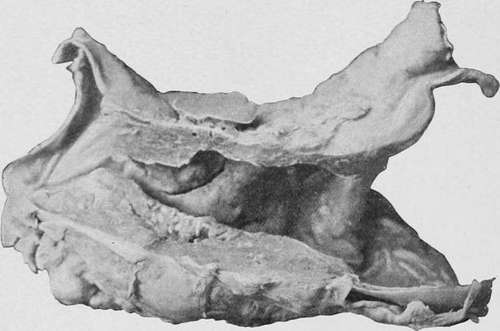Carcinoma Of The Pylorus
Description
This section is from the book "Cancer And Other Tumours Of The Stomach", by Samuel Fenwick. Also available from Amazon: Cancer and other tumours of the stomach.
Carcinoma Of The Pylorus
Disease of this part of the stomach constitutes about 60 per cent, of all the cases. The initial symptoms are usually those of indigestion, and for several months the chief complaint may be flatulence and distension after meals, acidity, constipation, loss of appetite, and emaciation. In every instance vomiting occurs sooner or later, and although at first it may only be occasional, and afford temporary relief to the other symptoms, it gradually increases in frequency until it is repeated once or twice each day. The ejecta are considerable in quantity, and consist of a sour-smelling fluid, in which undigested articles of food may be recognised which were eaten some days previously. From time to time an extreme degree of gastric intolerance is apt to develop from intercurrent gastritis, accompanied by incessant retching and vomiting of mucus. Pain is rarely severe until the growth has undergone ulceration, when great suffering maybe experienced, either continuously or within half an hour after food. Anorexia is usually pronounced, the tongue is foul, the bowels are confined, and the pulse is of low tension. Profuse haematemesis is comparatively rare, but both the vomit and the contents of the stomach extracted by a tube frequently contain small quantities of altered blood. The duration of life varies in different cases, fatal exhaustion usually ensuing within nine months when the pyloric obstruction is severe, while life may be prolonged for more than twice that period if the orifice is only slightly affected. Extension of the growth along the great curvature may produce obstruction of the colon or a fistula.
The chief sign of the disease consists of dilatation and hypertrophy of the stomach, which may be recognised by visible peristalsis, by stagnation of the food, and by a notable enlargement of the viscus on artificial inflation. Free hydrochloric acid disappears at an early period in the vast majority of the cases, and is replaced by an excess of lactic and other organic acids. The Oppler-Boas bacillus, torulae, sarcinse, and other micro-organisms may be recognised in the gastric contents, and the sulphocyanide of potassium in the saliva is greatly reduced in quantity. In about 71 per cent, of the cases a tumour may be detected in the epigastric, umbilical, or right hypochondriac region, which is of an oval or round shape, movable with respiration, and often capable of being displaced by the hand. Distension of the stomach displaces the tumour to the right, and when the organ is greatly dilated and the growth non-adherent to the liver the traction of the heavy viscus may drag the tumour into the lower part of the abdomen. Secondary deposits in the liver or peritoneum rarely coexist with severe stenosis of the pylorus.

Fig. 51.-Scirrhous carcinoma of the pylorus causing stenosis. (London Hospital Museum.).
Continue to:
- prev: Carcinoma Of The Body (Walls And Curvatures)
- Table of Contents
- next: Total Infiltration Of The Stomach
